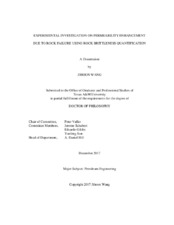| dc.description.abstract | Brittleness index is the rock failure property frequently used to predict the efficiency of the fracturing process in unconventional reservoir development. Although there have been various approaches in the brittleness quantification and its application, research on the relation of brittleness and permeability enhancement is hardly available. In this study, we analyze the ability of the various brittleness indices to predict the permeability enhancement observed in the laboratory scale.
Brittleness characterization approaches related to unconventional reservoirs were reviewed. Focusing on the laboratory scale, the multistage triaxial testing method was adopted to measure the rock properties without heterogeneity effect over the rock specimens.
Prior to the permeability measurement, the effect of the heterogeneity of the rock specimen was computationally analyzed. The permeability enhancement due to failure can be reliably obtained from the newly introduced characteristic time ratio measured before and after failure, even if the rock specimen is heterogeneous.
Rock property measurement tests were performed on 15 rock specimens including Newberry tuffs, Mancos shales and Middle East carbonates. It was found that the rock dilatancy and pre-existing natural fractures have influences on the failure properties, such as internal friction angle.
The nonlinear behavior on the stress-strain curves were computationally approached with finite element method. The local Poisson’s ratio was approximately formulated for both dilatant and non-dilatant rock specimens.
19 brittleness index theories were reviewed. Based on the availability of the measured data and the consistency of the calculated values, 4 indices were selected for further analysis. The brittleness index for each rock specimen was calculated by the selected theories.
The selected brittleness indices were calculated from the measured properties and were related to the permeability enhancement ratio. The results show that the brittleness indices determined from the stress-strain curve and the Mohr-Coulomb failure property are more predictive than the others. | en |


